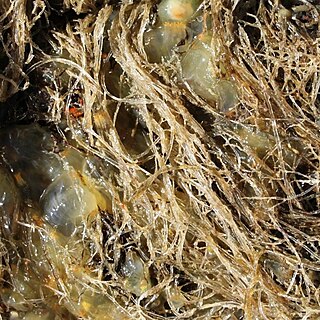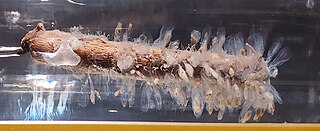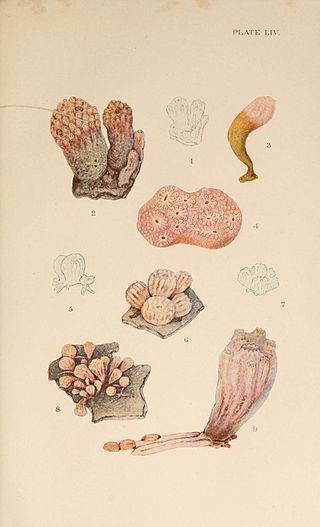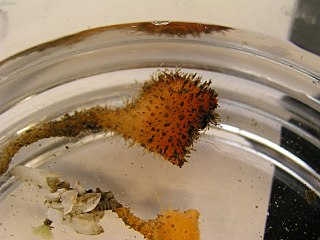
A tunicate is an exclusively marine invertebrate animal, a member of the subphylum Tunicata. This grouping is part of the Chordata, a phylum which includes all animals with dorsal nerve cords and notochords. The subphylum was at one time called Urochordata, and the term urochordates is still sometimes used for these animals. They are the only chordates that have lost their myomeric segmentation, with the possible exception of the seriation of the gill slits. However, doliolids still display segmentation of the muscle bands.

Ascidiacea, commonly known as the ascidians or sea squirts, is a paraphyletic class in the subphylum Tunicata of sac-like marine invertebrate filter feeders. Ascidians are characterized by a tough outer "tunic" made of a polysaccharide.

Ecteinascidia turbinata, commonly known as the mangrove tunicate, is a species of tunicate in the family Perophoridae. It was described to science in 1880 by William Abbott Herdman. The cancer drug trabectedin can be isolated from this species.

Perophora is a sea squirt genus in the family Perophoridae. Most species are found in shallow warm water but a few are found in higher latitudes. A colony consists of a number of zooids which bud off from a long slender stolon.

Atriolum robustum is a colonial tunicate or sea squirt in the family Didemnidae. It is native to the western and central Indo-Pacific where it is usually found anchored to a hard surface in shallow water.

Didemnum molle is a species of colonial tunicate in the family Didemnidae. It is commonly known as the tall urn ascidian, the green barrel sea squirt or the green reef sea-squirt. It is native to the Red Sea and the tropical waters of the Indo-Pacific region.

Didemnum vexillum is a species of colonial tunicate in the family Didemnidae. It is commonly called sea vomit, marine vomit, pancake batter tunicate, or carpet sea squirt. It is thought to be native to Japan, but it has been reported as an invasive species in a number of places in Europe, North America and New Zealand. It is sometimes given the nickname "D. vex" because of the vexing way in which it dominates marine ecosystems when introduced into new locations; however, the species epithet vexillum actually derives from the Latin word for flag, and the species was so named because of the way colonies' long tendrils appear to wave in the water like a flag.

Ciona savignyi is a marine animal sometimes known as the Pacific transparent sea squirt or solitary sea squirt. It is a species of tunicates in the family Cionidae. It is found in shallow waters around Japan and has spread to the west coast of North America where it is regarded as an invasive species.
Amathia vidovici is a species of colonial bryozoans with a tree-like structure. It is found in shallow waters over a wide geographical range, being found in both the Atlantic and Pacific Oceans and adjoining seas.

Amathia verticillata, commonly known as the spaghetti bryozoan, is a species of colonial bryozoans with a bush-like structure. It is found in shallow temperate and warm waters in the western Atlantic Ocean and the Caribbean Sea and has spread worldwide as a fouling organism. It is regarded as an invasive species in some countries.

Perophora regina is a species of colonial sea squirt in the genus Perophora. It is native to the tropical western Atlantic Ocean where it is found growing on mangrove roots on the Belize Barrier Reef.
Perophora multiclathrata is a species of colonial sea squirt in the genus Perophora. It is native to the tropical Indo-Pacific and the western Atlantic Ocean.

Morchellium argus, the red-flake ascidian, is a species of colonial sea squirt, a tunicate in the family Polyclinidae. It is native to shallow water in the northeastern Atlantic Ocean, especially round the coasts of Britain.

Polycarpa pomaria is a species of tunicate or sea squirt in the family Styelidae. It is native to the northeastern Atlantic Ocean where it lives on the seabed at depths down to about 450 metres (1,500 ft).

Dendrodoa grossularia is a species of tunicate or sea squirt in the family Styelidae, commonly known as the baked bean ascidian. It is native to the northeastern Atlantic Ocean where it is common in shallow water and on the lower shore in exposed rocky sites.
Stolonica socialis is a species of tunicate or sea squirt in the family Styelidae, commonly known as orange sea grapes. It is native to the northeastern Atlantic Ocean, where it lives on the rocky seabed in shallow water.

Distomus variolosus is a species of tunicate or sea squirt in the family Styelidae. It is native to the northeastern Atlantic Ocean where it lives on the seabed, typically on the stems and fronds of kelp.

Boltenia villosa is a species of tunicate, a marine invertebrate of the family Pyuridae. Common names include spiny-headed tunicate, hairy sea squirt, stalked hairy sea squirt and bristly tunicate. This species was first described in 1864 by the American marine biologist William Stimpson who gave it the name Cynthia villosa. It was later transferred to the genus Boltenia. The type locality is Puget Sound, Washington state, United States.

Halocynthia igaboja, commonly known as sea hedgehog, bristly tunicate or spiny sea squirt, is a species of tunicate in the family Pyuridae. It is native to the northeastern Pacific Ocean. This species was first described in 1906 by the Japanese marine biologist Asajiro Oka, who gave it the name Cynthia ritteri. It was later transferred to the genus Halocynthia.

Clavelina ossipandae, the skeleton panda sea squirt or skeleton panda ascidian, is a species of colonial ascidian, a group of sessile, marine filter-feeding invertebrates. Originally discovered near Kume Island in Japan by local divers, pictures of the animal attracted attention in the media for its appearance prior to its formal taxonomic description in 2024.

















